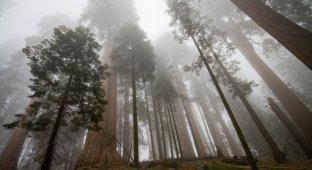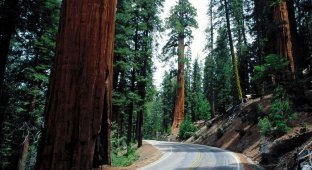The tallest long-lived trees in the world are sequoias. The plants are common in North America and can take four thousand years to develop. For the first time, local residents discovered unusual trees back in the 19th century in the Sierra Nevada mountains, and then no one believed that such huge representatives of the flora existed. The first mention of hundred-meter giants is in a book by a man named Leonard. Unfortunately, readers decided that they had been deceived.
Twenty years passed, and crowds of gold seekers flocked to these places. Daoud, one of the “seekers of happiness,” chased a grizzly bear he had wounded and... ran into a solid wooden wall. It was not a fence built by people, but a huge wooden fortress grown by nature. The hunter returned and told about the amazing discovery. He was ridiculed.

Then Daoud cheated. He said he killed a bear the size of a large house. At this point everyone ran into the forest and... saw a grove of redwoods! People stood in silent amazement in front of the giants, next to whom they seemed smaller than ants. From that time on, all of America believed in the existence of supergiant trees, and everyone rushed in search of sequoias.

A total of 72 groves were found, and each tree in them received its own name: “old bachelor”, “three sisters”, “miner’s hut”, and a fallen tree with a hollow into which a rider could ride was called a “riding school”. There is even a sequoia named after the writer Mark Twain.
Enterprising businessmen bought these groves and let tourists in for money. Well, in fact, where else can you see a tunnel cut into a trunk, where a horse-drawn carriage can freely pass! This tunnel still exists - there is a road along it and cars are moving in a stream.



Unfortunately, these stumps and tunnels were made by people specifically to show how big the sequoias are and to make a lot of money from it. The good news is that giants are extremely tenacious: they can be maimed, but they are very difficult to kill.
We decided to cut down one of the tallest sequoias especially for the exhibition, but it didn’t work out: the saws became dull very quickly. Then powerful drills went into action. For almost a month, five workers tried to make holes in the trunk from different sides. But even then the tree did not fall.

Sequoia collapsed to the ground only after a barrage of hurricane winds hit her riddled body. The impact was like an earthquake. The trunk fell into several pieces, and the branches cut deep into the ground. It was never possible to remove the fallen giant from the forest. They delivered only the bark stripped from it. In San Francisco, a huge round room seven meters high was assembled from it. A piano was placed inside and seats were provided for 40 spectators.
Alas, the bullying of the sequoias did not end there. Lumberjack Trask decided to enrich himself by robbing a tree that was known as the Mother of the Forest. He drove iron staples into the trunk to reach the top, and then stripped the bark from the tree and sent the “tree clothes” to London.

Trees without bark usually die. The mother of the forest survived. She towered above the treetops, reproaching people with her appearance for their greed and unjustified cruelty. And now, many years later, Americans blush, remembering Trask’s monstrous act

Redwoods are kind to people, and there is no need to disfigure them. Hunter Smith once discovered a huge hollow in the trunk of a sequoia tree. It was formed when a fire raged in the forest. The fire burned a 35-meter grotto in the trunk. It was there that Smith settled. For three years he enjoyed his unprecedented apartment. But one day a hurricane came.
The hunter sat like a squirrel in a hollow, shaking with fear. Huge trees fell nearby. A sequoia with a scorched trunk could also not survive - it could collapse and bury the hunter hiding in it. However, she survived: she has not experienced such storms in the past thousands of years!

It must be said that new trees appear very rarely, but, on the other hand, no one has seen sequoias die of old age. This is exactly what Ross, the chief forester of Sequoia National Park in California, wrote аbout: “No one has ever seen a giant sequoia dying of old age. The same trunks that rest on the ground fell not because of age, but because of a natural disaster.”

Yes, redwoods, like gods, can live for a very long time, and if compared with the brevity of human life, then we can say that it is eternal! Their age is equal to the life of entire states. For example, in one American museum there is a cut tree with annual rings. Each ring marks dates and events that took place in the life of the United States.+
When the Viking boats arrived on the shores of America, this tree was already standing. At the time of Columbus it was already gigantic. In the White House, presidents succeeded each other, and the sequoia continued to grow and, perhaps, did not even know about the existence of people who would someday pick up its fallen trunk from the ground, cut it into pieces and put it in a museum.

In a word, the very appearance of this tree, its greatness and age, it would seem, should inspire respect in people, but for a long time they tried to saw them with electric saws, and when that didn’t work, they blew them up with dynamite.
The most annoying thing about this barbarity is that the soft sequoia wood is not good for anything: it can only be cut into pegs or made into matches. Well, they blew up the patriarchs of the forest for this purpose too. Or they made souvenirs out of them. Trinkets carved from the body of the “World Tree” are eagerly purchased by tourists.
Giant sequoias have a relative - the evergreen sequoia, or, as the Americans call it, mahogany. Its girth is smaller, and its age is more modest (“only” some two and a half thousand years), but they are taller: one hundred and ten meters is not a record for them at all.
And one more thing - red trees worry about procreation. They grow up to five million cones on one tree: what if one of them survives and becomes a giant tree? And even dead red trees that have fallen to the ground produce green shoots.+
Well, if people don’t blow up redwood trees with dynamite, then maybe our great-great-great-grandchildren will admire them too.


























